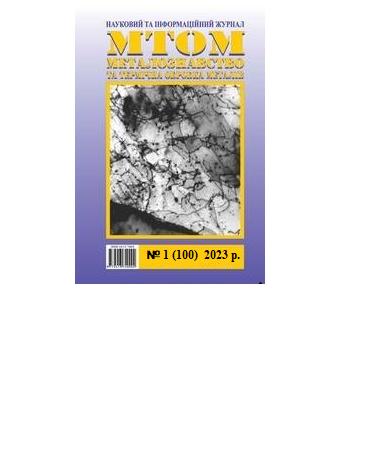THE INFLUENCE OF CHEMICAL COMPOSITION, HEATING TEMPERATURE AND COOLING RATE ON THE FORMATION OF STRUCTURAL COMPONENTS OF STEELS
DOI:
https://doi.org/10.30838/J.PMHTM.2413.280323.52.945Keywords:
carbon steel, dendritic crystallization, segregation of manganese and silicon, additional heating above the liquidus line, cooling rateAbstract
Problem statement. The formation of structural components starts with the hardening of steels. Therefore, it is important to investigate the influence of chemical composition, temperature of additional heating and cooling rate of the melt on the formation of structural components of steels. The purpose of the research – to compare the influence of the chemical composition, heating temperature and cooling rate on the formation of structural components in steels. Methods. To determine the features of the structural state of steels, we use microstructural analysis, X-ray microanalysis, X-ray diffraction method and surface etching of specimens with nital and hot solution of sodium picrate. Results. In the work, a study of steel specimens with different carbon, manganese and silicon content was carried out. We compared the structural state of steel in the cross-section of continuous cast steel billet and steel of a similar chemical composition after additional heating above the liquidus line at 50 °C, 150 °C and cooling at rates of 10–104 °C/s. Scientific novelty. It was found that in the process of manufacturing of continuous cast steel billets, when cooling in a crystallizer at the rate of ~104 ºС/s in the surface zone of the billet of steels with a carbon content of ≥ 0.5 wt.%, manganese ≥ 0.75 wt.% and silicon ≥ 0.45 wt.% the δ-ferrite formation and γ-iron dendrites formation from the melt are completely suppressed. For the first time, the effect of heating temperature above the liquidus line up to 150 °С and cooling rate of 10–103 °С/s on the structure formation of experimental carbon steels was investigated. It was established that additional heating above the liquidus line and cooling at rates of 102–103°C/s almost completely inhibits the formation of ferrite along the grain boundaries, enhances formation of a more uniform structure, an increase in the dispersion of structural components, simultaneous solid-solution and dispersion hardening of steel, and improvement of mechanical properties of steels. In addition, a decrease in the volume fraction of the areas containing liquation elements (manganese and silicon) was observed. The areas were distributed more evenly, which suggests that there could be a decrease in the difference in the content of chemical elements, compared to the condition without additional heating of the melt. Practical value. The use of the obtained results could allow to develop technologies for obtaining steels with a more uniform structure.
Downloads
Published
Issue
Section
License
Authors that are published in this journal agree to follow the conditions:
Authors reserve the right to the authorship of his work and cede the right to the journal of first publication of this work on conditions of the license under the Creative Commons Attribution License, which allows others to distribute it freely with the obligatory reference to the author of the original work and the first publication of the work in this journal.

